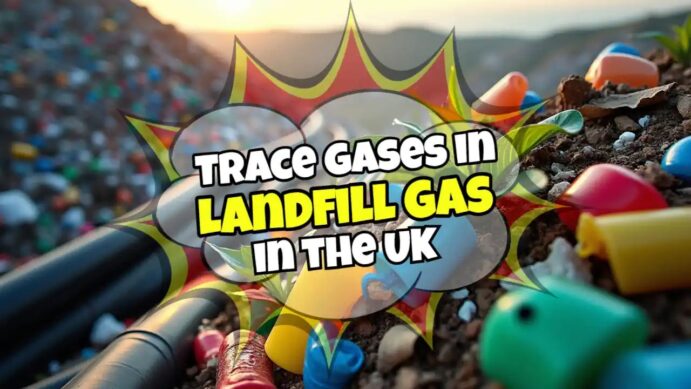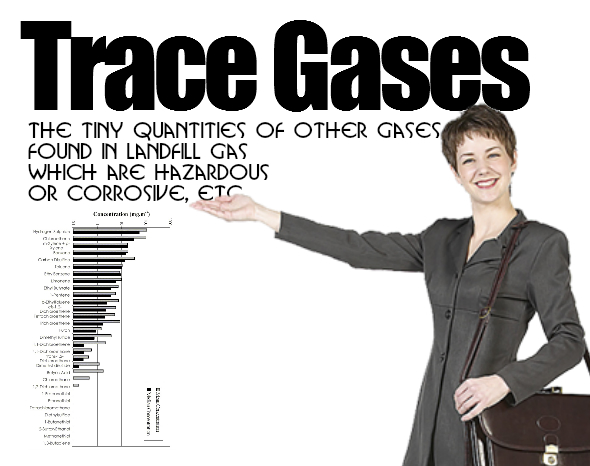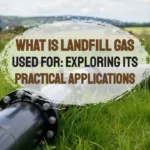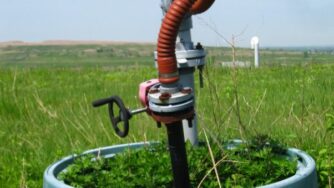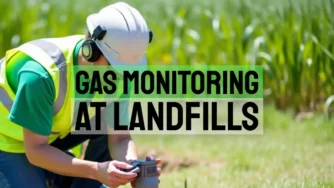Trace gases in UK landfill gas include a mix of volatile organic compounds (VOCs), hydrogen sulfide, nitrogen, and others, which are found alongside the main components of methane and carbon dioxide. Specific trace gases can include aromatics like benzene, toluene, ethyl benzene, and xylenes, along with oxygenated compounds and aliphatic hydrocarbons. These are produced by the breakdown of organic waste, volatilisation of chemicals, and microbial action within the landfill.
Trace Gases in Landfill Gas – Key Takeaways
- Over 500 trace components have been identified in UK landfill gas, with hydrogen sulphide, vinyl chloride, carbon disulphide, and BTEX compounds typically showing the highest concentrations.
- Trace gases, while comprising less than 1% of landfill gas volume, pose significant environmental and health risks through their toxicity, odour potential, and contribution to ground-level ozone formation.
- Landfill Gas instrument suppliers provide sophisticated monitoring systems that can detect these trace components at parts per billion levels, critical for maintaining regulatory compliance.
- The composition of trace gases varies significantly throughout a landfill's lifecycle, with different phases presenting unique chemical signatures and environmental challenges.
- Proper understanding of trace gas compositions is essential for designing effective gas collection systems and determining whether energy recovery or flaring is the optimal management strategy.
What's Actually in UK Landfill Gas? The Hidden Chemicals You Should Know
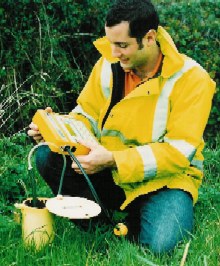 Beneath the surface of every UK municipal solid waste landfill lies a complex chemical ecosystem generating gases that tell the story of our consumption patterns and waste management practices.
Beneath the surface of every UK municipal solid waste landfill lies a complex chemical ecosystem generating gases that tell the story of our consumption patterns and waste management practices.
While methane and carbon dioxide dominate the headlines as the primary landfill gases, they're only part of a much more intricate chemical narrative. The trace gases—those components present in concentrations of less than 1% by volume—reveal critical information about environmental impacts, health risks, and even the maturity stage of a landfill site.
Research conducted by the Environment Agency has identified more than 500 trace components in typical UK landfill gas, ranging from volatile organic compounds (VOCs) to sulfur-based gases and halogenated compounds. These trace components may be present in minute quantities, but their environmental significance cannot be overstated.
They're produced through various mechanisms, including direct volatilisation from disposed products, microbial decomposition processes, and chemical reactions occurring within the waste mass. Understanding these trace gases has become increasingly important for Landfill Gas Management, which specialises in monitoring and mitigating the environmental impacts of these hidden chemicals.
Main Components of Landfill Gas in UK Waste Sites
Before diving into trace components, it's essential to understand the baseline composition of landfill gas. A typical UK municipal solid waste landfill produces gas that primarily consists of methane (40-60%) and carbon dioxide (30-40%), with the remainder made up of nitrogen, oxygen, water vapour, and trace gases.
This composition represents the signature of anaerobic decomposition processes that dominate mature landfill environments, where organic matter breaks down in the absence of oxygen.
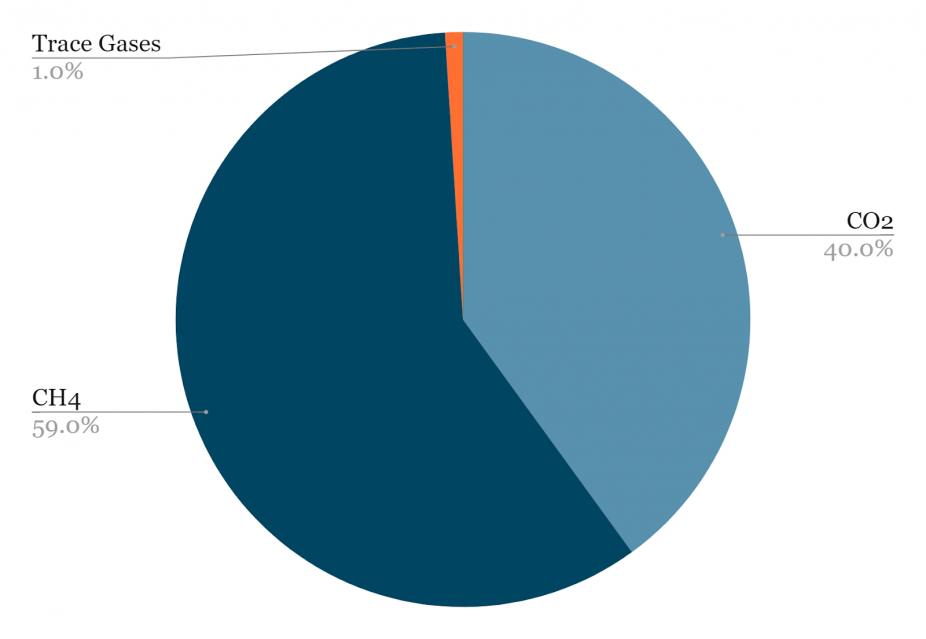
“Landfill Gas Generation & Collection …” from www.geoengineer.org and used with no modifications.
Methane and Carbon Dioxide: The Dominant Gases
Methane is the primary energy-containing component of landfill gas, with a high calorific value that makes it valuable for energy recovery. With a global warming potential approximately 28 times that of carbon dioxide over a 100-year period, methane represents both an environmental challenge and an energy opportunity.
Carbon dioxide, while less potent as a greenhouse gas on a molecule-by-molecule basis, is produced in substantial quantities and contributes significantly to the overall greenhouse footprint of landfill sites. The ratio between these two gases often serves as an indicator of the biological stability and maturity of the waste mass, with higher methane proportions typically observed during peak gas production phases.
Nitrogen and Oxygen Levels: What They Tell Us
The presence of nitrogen and oxygen in landfill gas provides valuable diagnostic information about the collection system's integrity and the landfill's operational conditions. Elevated oxygen levels (above 1%) often indicate air intrusion, which can occur through poor cover materials, ineffective gas wells, or over-extraction.
Such intrusion not only dilutes the energy content of the gas but also creates potentially hazardous conditions where methane and oxygen could form explosive mixtures.
Nitrogen levels typically range from 2-5% in well-managed systems, but can increase significantly with air infiltration. The N₂/O₂ ratio differs from atmospheric air (3.76 vs. 4.0) due to preferential consumption of oxygen by aerobic microorganisms at the landfill-atmosphere interface, making this ratio a useful diagnostic tool for landfill operators.
Trace Gases That Cause Environmental Concerns
While constituting less than 1% of landfill gas volume, trace components present disproportionate environmental and health challenges. Recent UK studies have identified priority trace gases based on their concentration, toxicity, persistence, and mobility.
These components vary significantly across different landfills and even within different areas of the same site, reflecting variations in waste composition, age, and management practices. The Environment Agency's comprehensive assessment (2003) established a priority list of trace components that require particular attention in UK municipal solid waste landfills.
Volatile Organic Compounds (VOCs) Found in UK Landfills
The BTEX compounds (benzene, toluene, ethylbenzene, and xylenes) consistently appear among the highest concentration VOCs in UK landfill gas samples. These aromatic hydrocarbons originate from various consumer products, including solvents, paints, and petroleum-based materials.
Benzene deserves special attention due to its confirmed carcinogenicity and relatively high mobility in the environment. Typical concentrations of benzene in UK landfill gas range from 0.2 to 6.0 mg/m³, which exceeds ambient air quality standards by several orders of magnitude. Other significant VOCs include limonene (from citrus products and cleaners), alpha-pinene (from wood products), and various ketones and aldehydes that contribute to the characteristic odor profile of landfill gas.
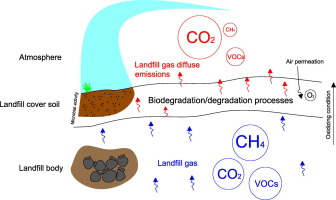
“Volatile organic compounds (VOCs) in …” from www.sciencedirect.com and used with no modifications.
Sulfur Compounds and Their Distinct Odours
Hydrogen sulfide (H₂S) stands out as the most significant sulfur-based trace component in UK landfill gas, with concentrations typically ranging from 3 to 300 mg/m³. This colourless gas, recognisable by its characteristic “rotten egg” odour, is detectable by human olfaction at extraordinarily low concentrations (0.0005 ppm).
The presence of H₂S results primarily from the degradation of gypsum (calcium sulfate) in plasterboard when it comes into contact with water and organic matter in anaerobic conditions. UK landfills receiving construction and demolition waste tend to show elevated levels of hydrogen sulfide, creating significant odour management challenges even when the gas is diluted in ambient air.
Other sulfur compounds, including dimethyl sulfide, dimethyl disulfide, and methanethiol (methyl mercaptan), contribute to the complex odour profile of landfill gas. These compounds have extremely low odour thresholds, making them perceptible even when present at sub-ppm concentrations.
A 2003 Environment Agency study found that methanethiol was present in concentrations ranging from 0.5 to 6 mg/m³ in typical UK landfills, while dimethyl sulfide ranged from 0.2 to 8 mg/m³. These sulfur compounds are particularly problematic because conventional flaring systems may not destroy them, potentially converting them to sulfur dioxide, which presents its own environmental challenges.
Halogenated Compounds and Their Sources
Chlorinated and fluorinated compounds represent another significant category of trace gases in UK landfill gas, with vinyl chloride (chloroethene) frequently detected at concentrations between 0.5 and 20 mg/m³.
This compound, classified as a Group A human carcinogen, forms primarily as a degradation product of chlorinated solvents and polyvinyl chloride (PVC) materials. The concentrations of halogenated compounds tend to be higher in older landfills that received waste before strict regulations on hazardous waste disposal came into effect.
Dichlorofluoromethane (CFC-21) and trichlorofluoromethane (CFC-11) are among the most commonly detected chlorofluorocarbons in UK landfill gas, reflecting historical disposal of refrigeration equipment and aerosol products.
While their concentrations have declined in newer landfill cells following the Montreal Protocol restrictions, they persist in older waste deposits. These compounds not only contribute to stratospheric ozone depletion but also present challenges for energy recovery systems due to their potential to form corrosive hydrochloric acid when combusted.
Heavy Metals in Vapour Form
Though typically considered solid contaminants, several heavy metals can exist in the vapour phase within the landfill environment. Mercury stands as the most significant metallic trace component, capable of volatilizing even at ambient temperatures.
Studies of UK landfills have detected mercury vapour at concentrations ranging from 0.05 to 17 μg/m³, with higher levels typically associated with sites that received industrial waste or discarded fluorescent lighting fixtures. The presence of other organometallic compounds, particularly those containing arsenic and tin, has been documented, but at significantly lower concentrations.
The mobility of these metallic components in the vapour phase presents unique challenges for gas treatment systems. Conventional carbon filtration systems show variable efficiency in capturing mercury vapour, necessitating specialised treatment approaches when elevated concentrations are detected. This has prompted some UK landfill operators to implement pre-screening procedures specifically targeting mercury-containing waste streams before disposal.
Concentration Ranges of Key Trace Components
Quantifying trace gases in landfill environments presents significant technical challenges due to their low concentrations and the dynamic nature of gas production. The Environment Agency's comprehensive 2003 study established benchmark concentration ranges for priority trace components based on data from multiple UK sites. This research identified significant variations both between different landfills and within different areas of the same site, reflecting the heterogeneous nature of waste composition and decomposition processes.
Figure 1. Mean and median concentrations of trace components of particular interest(1)
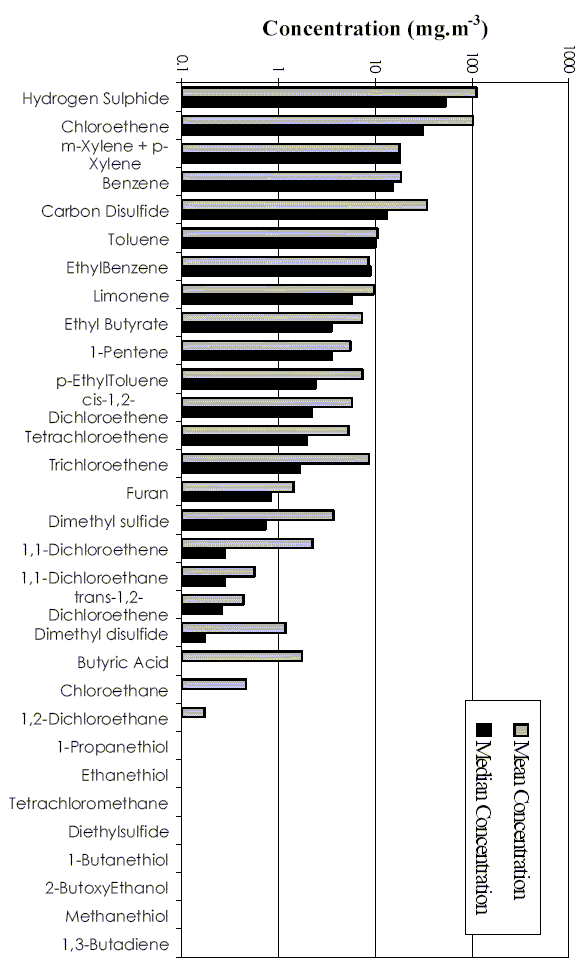
Typical Concentration Levels in Active UK Landfills
Recent monitoring data from active UK municipal solid waste landfills reveals a consistent pattern of priority trace components. Hydrogen sulfide, vinyl chloride, carbon disulfide, and BTEX compounds typically exhibit the highest concentrations among analyzed components. The table below summarises the typical concentration ranges for key trace components in raw landfill gas from UK sites. For more details on monitoring procedures, refer to landfill gas monitoring procedures.
Mean and Median Trace Components in Typical UK Landfill Gas
To ensure accurate data collection, it is essential to follow proper landfill gas monitoring procedures when analyzing trace components in landfill gas.
Hydrogen sulfide: 20-250 mg/m³ (mean: 97 mg/m³)
Vinyl chloride: 1-15 mg/m³ (mean: 7.8 mg/m³)
Carbon disulfide: 0.5-30 mg/m³ (mean: 5.2 mg/m³)
Benzene: 0.5-5 mg/m³ (mean: 2.1 mg/m³)
Toluene: 1-35 mg/m³ (mean: 14.5 mg/m³)
Dichlorofluoromethane: 0.2-8 mg/m³ (mean: 3.7 mg/m³)
p,m-Xylene: 1-25 mg/m³ (mean: 8.5 mg/m³)
Source: Environment Agency (2003) Investigation of the Composition and Emissions of Trace Components in Landfill Gas
These concentration ranges represent raw landfill gas prior to any treatment or dilution processes. The actual emissions to the atmosphere are typically several orders of magnitude lower due to collection system efficiencies, treatment processes, and atmospheric dispersion. Nevertheless, these baseline concentrations provide essential reference points for designing monitoring programs and evaluating treatment technologies.
How Concentrations Change During the Landfill Lifecycle
The composition and concentration of trace gases evolve significantly throughout a landfill's operational and post-closure phases. Fresh waste deposits initially undergo an aerobic decomposition phase characterised by relatively low methane production but potentially elevated levels of certain VOCs through direct volatilisation.
As oxygen becomes depleted and anaerobic conditions dominate, methane production increases while many trace component concentrations peak during this active methanogenic phase, typically 2-10 years after waste placement.
Long-term monitoring of UK landfills reveals that most VOC concentrations decline gradually over decades as source materials deplete, though this decline occurs at different rates for different compounds.
Halogenated compounds like vinyl chloride may persist longer due to ongoing formation through sequential dechlorination processes. Hydrogen sulfide concentrations often show more variable temporal patterns, sometimes increasing when conditions favour sulfate reduction, such as during infiltration events that mobilise sulfate from construction waste.
The maturation phase of landfills (typically 30+ years after closure) shows a general decline in both bulk gas production and trace component concentrations, though the rate of decline varies significantly based on waste composition, moisture conditions, and engineering controls. Research at several UK reference sites indicates that certain recalcitrant compounds may persist at detectable levels for 50+ years, highlighting the importance of long-term monitoring strategies for closed landfill facilities.
Sources of Trace Gases in Municipal Waste
Understanding the origins of trace gases provides crucial insights for both waste management practices and gas treatment strategies. The trace components in landfill gas can be broadly categorised into three source mechanisms: direct volatilisation from disposed materials, byproducts of biological decomposition processes, and secondary compounds formed through chemical reactions within the landfill environment.
Recent waste composition analyses in the UK suggest that changing consumer product formulations and waste diversion programs have gradually altered the trace gas profile of newer landfill cells.
Household Chemical Products
Common household products represent significant sources of VOCs and other trace components in landfill gas. Cleaning products, personal care items, paints, and solvents contain numerous volatile compounds that can readily partition into the gas phase within the landfill environment.
A 2016 UK waste characterisation study found that approximately 1.2% of household waste consisted of potentially hazardous materials containing volatile compounds, despite separate collection programs for hazardous waste.
UK Regulations for Landfill Gas Management
The regulatory framework governing landfill gas management in the United Kingdom has evolved significantly over the past three decades, shaped by growing environmental awareness and European Union directives.
The Environmental Permitting (England and Wales) Regulations 2016 serve as the primary legislative mechanism controlling landfill gas emissions, incorporating the requirements of the EU Landfill Directive (1999/31/EC). These regulations operate on the principle that landfill operators must take all necessary measures to collect, treat, and utilise landfill gas where economically and technically feasible, or otherwise destroy it through controlled combustion.
UK regulatory authorities have adopted a risk-based approach to landfill gas management, recognising that different sites present different hazard profiles based on waste composition, proximity to receptors, and geological setting.
The Integrated Pollution Prevention and Control (IPPC) permitting regime requires operators to implement Best Available Techniques (BAT) for gas management, which includes comprehensive monitoring of both bulk gases and trace components. This approach ensures that control measures are proportionate to the specific risks presented by each facility.
The Climate Change Act 2008 introduced additional considerations by establishing legally binding targets for greenhouse gas emission reductions. With landfills representing approximately 3% of UK greenhouse gas emissions, the management of methane has taken on increased regulatory importance. This has led to more stringent requirements for gas collection efficiency and utilisation, indirectly benefiting trace gas management through improved overall gas control.
Environment Agency Requirements
The Environment Agency serves as the principal regulatory body overseeing landfill operations in England, with equivalent bodies in Scotland (Scottish Environment Protection Agency), Wales (Natural Resources Wales), and Northern Ireland (Northern Ireland Environment Agency).
The Agency's Technical Guidance Note LFTGN03 (Guidance on the Management of Landfill Gas) establishes specific requirements for gas control systems, including collection efficiency targets that indirectly affect trace gas emissions. For municipal solid waste landfills, operators must demonstrate gas collection efficiencies of at least 85% during the active operational phase and maintain appropriate collection during the aftercare period.
Specific to trace gases, the Environment Agency's LFTGN04 guidance document (Guidance for Monitoring Trace Components in Landfill Gas) defines monitoring protocols based on the Agency's priority list of compounds. This guidance requires more frequent monitoring for sites with higher risk profiles, such as those in close proximity to residential areas or those that have accepted industrial wastes.
The guidance specifies that operators must conduct periodic speciated analysis for trace components using methods capable of detecting compounds at the parts-per-billion level, including GC-MS techniques with appropriate sample concentration procedures.
Monitoring and Reporting Obligations
UK landfill operators face comprehensive monitoring and reporting requirements for trace gases under their environmental permits. Typical monitoring regimes include quarterly sampling of raw landfill gas at strategic collection points, with analysis for a standard suite of trace compounds including hydrogen sulfide, BTEX compounds, key halogenated compounds, and selected sulfur species.
The frequency and scope of monitoring may increase where initial results indicate elevated concentrations or where specific risk factors have been identified through the site's environmental risk assessment.
Reporting obligations typically include annual submission of monitoring data through the Environment Agency's electronic data management system, with exceedances of threshold values triggering more immediate notification requirements.
The concept of “trigger levels” features prominently in UK regulatory practice, with site-specific thresholds established based on potential impact pathways and receptor sensitivity. When these triggers are exceeded, operators must implement pre-defined contingency actions and undertake additional investigative monitoring to characterise the extent and source of elevated concentrations.
Compliance Standards and Thresholds
Rather than establishing universal concentration limits for trace gases in raw landfill gas, UK regulations employ a tiered approach to compliance thresholds.
The primary compliance mechanism for trace gases in landfill gas focuses on emissions to the atmosphere after treatment, with standards derived from the Air Quality Standards Regulations 2010 and the Environmental Assessment Levels (EALs) published by the Environment Agency. For most trace components, compliance is demonstrated through dispersion modelling that shows predicted ground-level concentrations at sensitive receptors remain below health-based standards with an appropriate margin of safety.
Mitigation and Control Technologies
Effective management of trace gases begins with proper gas collection, followed by appropriate treatment based on the specific composition profile of the site.
UK landfills typically employ a combination of passive and active collection systems, with treatment options including thermal destruction (flaring or combustion in engines/turbines), adsorption on activated carbon, and biological treatment methods.
The selection of appropriate technologies depends on factors including gas composition, flow rates, proximity to sensitive receptors, and economic considerations, including potential energy recovery value.
Gas Collection Systems Design
The foundation of trace gas control lies in effective gas collection infrastructure. UK landfills typically employ networks of vertical extraction wells spaced 40-60 meters apart, supplemented by horizontal collectors in active filling areas.
The design philosophy has evolved toward installing collection infrastructure progressively during site operation rather than retrofitting after closure, allowing earlier capture of gases, including trace components.
Typical Gas Collection System Components in UK Landfills
For effective management of landfill gas, it is crucial to understand the components of a typical gas collection system. In the UK, these systems are designed to efficiently capture and control emissions. To learn more about UK landfill gas emissions control, consider exploring further resources.
Vertical extraction wells: Typically 450-600mm diameter, extending to 80% of waste depth
Horizontal collectors: HDPE pipes installed during waste placement
Wellhead controls: Individual flow and vacuum adjustment capability
Condensate management: Knockout pots and pumping systems
Monitoring points: Strategically placed ports for gas composition sampling
Balancing systems: Automatic or manual adjustment to optimise collection
Main gas transmission lines: Sized for peak flow plus 30% capacity margin
Source: Environment Agency (2004) Guidance on Landfill Gas Collection System Design
Modern collection systems incorporate real-time monitoring capabilities that allow operators to detect and respond to changes in gas composition. Advanced systems include automated balancing that adjusts vacuum levels based on methane concentration, helping to minimise air intrusion while maximising collection efficiency.
This optimisation directly benefits trace gas management by ensuring that the maximum proportion of generated gas is captured before it can migrate through cover systems or surrounding geology. For more information on these systems, check out this article on gas monitoring at landfills.
The materials selection for gas collection infrastructure has significant implications for trace gas management. Early collection systems often employed steel components that were susceptible to corrosion from acidic trace gases, particularly hydrogen sulfide and halogenated compounds.
Contemporary designs favour HDPE and other corrosion-resistant materials, with specific consideration given to potential reactions with trace components. Specialised sealing compounds and gasket materials resistant to VOC degradation help maintain system integrity and minimise fugitive emissions.
Flaring vs. Energy Recovery Options
The decision between flaring and energy recovery represents a critical consideration for trace gas management. High-temperature enclosed flares (operating at 1000-1200°C with residence times >0.3 seconds) achieve destruction efficiencies exceeding 99.9% for most VOCs and 98% for halogenated compounds.
Modern flare systems include automated combustion controls that maintain optimal destruction conditions even as gas composition varies. The Environment Agency's technical guidance specifies minimum operating parameters, including temperature, residence time, and oxygen levels, to ensure effective destruction of trace components. For more information, explore UK landfill gas emissions control.
Energy recovery systems, including reciprocating engines and gas turbines, typically operate at lower temperatures than flares, potentially resulting in reduced destruction efficiencies for certain trace components. However, these systems often incorporate pre-treatment technologies such as siloxane removal systems that also reduce concentrations of other trace compounds.
The decision between flaring and energy recovery increasingly involves a comprehensive assessment of trace component destruction, with some facilities employing selective routing of gas streams based on their composition profile. Gas streams with elevated concentrations of problematic trace compounds (particularly chlorinated species) may be directed to flares optimised for destruction, while cleaner streams support energy generation.
Biofilter Applications for Trace Gas Removal
Biological treatment technologies have gained increasing acceptance for managing low-calorific value gas streams and dilute emissions from landfill surfaces. Biofilters employ microbial communities supported on organic media (typically composted materials) to oxidise methane and degrade trace organic compounds.
UK field trials have demonstrated removal efficiencies of 60-90% for many trace VOCs, with particularly strong performance for aromatic and oxygenated compounds. These systems show variable performance for halogenated compounds and require careful design considerations for sites with elevated hydrogen sulfide concentrations.
Frequently Asked Questions About Trace Gases in Landfill Gas
The complex nature of trace gases in landfill environments generates numerous questions from stakeholders, including local communities, regulatory authorities, and waste management professionals. The following section addresses the most common inquiries based on current UK research and monitoring data, providing evidence-based responses to help clarify the implications of trace gas emissions.
What are the most harmful trace gases found in UK landfills?
The potential harm from trace gases must be evaluated based on toxicity, concentration, and exposure pathways. Vinyl chloride consistently ranks among the highest concern compounds due to its confirmed carcinogenicity and relatively high concentrations in landfill gas (typically 1-15 mg/m³ in raw gas).
Benzene presents similar concerns as a known human carcinogen, though typically at lower concentrations. Hydrogen sulfide, while not carcinogenic, presents acute toxicity risks at high concentrations and significant odour impacts even at extremely low levels.
For landfills that received industrial wastes before modern restrictions, mercury vapour may present long-term health concerns due to its high toxicity and environmental persistence. Understanding these landfill gas risks is crucial for assessing potential health impacts.
The relative harm also depends on site-specific factors, including proximity to receptors, meteorological conditions, and the effectiveness of gas management systems. The Environment Agency's risk assessment methodology considers both the intrinsic hazard of compounds and these site-specific exposure factors.
Modern gas collection and treatment technologies can effectively mitigate risks from even the most concerning trace components when properly designed and operated.
How far can landfill trace gases travel in the atmosphere?
- Dispersion characteristics vary significantly by compound, with factors including molecular weight, water solubility, and reactivity influencing atmospheric transport
- Hydrogen sulfide typically undergoes oxidation to sulfur dioxide within 2-4 km of the source under average meteorological conditions
- VOCs, including BTEX compounds, may persist for 5-10 km before significant degradation occurs
- Halogenated compounds show the greatest persistence, potentially travelling 10-15 km before substantial degradation
- Meteorological conditions dramatically influence dispersion distances, with temperature inversions potentially extending impact ranges by 200-300%
Atmospheric dispersion modelling conducted for UK landfills typically shows that ground-level concentrations of trace gases decrease by 1-2 orders of magnitude within 500 meters of the site boundary under normal operating conditions. This rapid dilution explains why odour impacts often represent the most noticeable off-site effect, as the human olfactory system can detect certain compounds (particularly sulfur species) at extraordinarily low concentrations.
Lateral migration through geological pathways represents a separate transport mechanism that can potentially deliver trace gases to receptors independent of atmospheric dispersion. UK regulatory guidance requires specific risk assessment for this pathway, with monitoring requirements for perimeter boreholes where potential migration routes are identified.
The distance of lateral migration depends primarily on geological conditions, with documented cases of migration through permeable strata extending up to 300 meters from the waste boundary.
Recent advances in remote sensing technology, particularly differential optical absorption spectroscopy (DOAS) and open-path FTIR systems, have enhanced our understanding of trace gas dispersion from UK landfills. These technologies allow real-time mapping of plume characteristics under varying meteorological conditions, providing valuable data for validating dispersion models and optimising control strategies.
Do modern landfills produce fewer trace gases than older sites?
Modern landfills demonstrate significantly different trace gas profiles compared to facilities developed before the implementation of the EU Landfill Directive.
The restriction of hazardous waste disposal in municipal solid waste landfills has substantially reduced concentrations of many chlorinated compounds, while improved source segregation has decreased volatile metals, including mercury.
Comparative studies between pre-2000 and post-2010 UK landfill cells show reductions of 60-90% for priority halogenated compounds and 40-70% for BTEX compounds.
However, hydrogen sulfide concentrations have not shown consistent reductions due to continuing disposal of sulfate-bearing construction materials, though improved management practices, including selective placement and pre-treatment, have helped mitigate this issue at well-managed facilities.
Can landfill trace gases affect property values?
Economic impact studies in the UK have identified correlations between landfill proximity and property values, though the relationship is complex and influenced by multiple factors. A 2018 analysis of housing transactions near 11 UK landfills identified average property value reductions of 2.6-7.3% within 1km of active sites, with the most significant impacts associated with facilities experiencing documented odour issues.
The primary economic impact mechanism appears to be perception of odour potential rather than actual health risks, with hydrogen sulfide and other odorous trace gases playing a disproportionate role in economic impacts despite their relatively low toxicity. Importantly, sites with effective gas management systems demonstrated substantially lower property value impacts (average 1.8% reduction), highlighting the economic value of comprehensive trace gas control beyond regulatory compliance.
What symptoms might indicate exposure to landfill trace gases?
Health effects from trace gases depend on specific compounds, concentration levels, and duration of exposure. At the concentrations typically encountered in ambient air near well-managed UK landfills, acute health effects are rare. However, under upset conditions or at poorly managed sites, certain symptoms may indicate potential exposure.
Hydrogen sulfide exposure can cause eye irritation, headaches, and nausea at concentrations above 0.5-10 ppm, with the characteristic “rotten egg” odour serving as a warning sign (though olfactory fatigue can occur with continued exposure). For more information on monitoring these gases, refer to landfill gas monitoring procedures.
VOCs, including benzene and toluene, may cause symptoms including headache, dizziness, and eye/respiratory irritation at elevated concentrations. These symptoms typically resolve quickly when exposure ceases. The UK Committee on the Medical Effects of Air Pollutants (COMEAP) notes that odour perception often triggers symptoms through stress response mechanisms even at concentration levels below those known to cause direct physiological effects.
Long-term, low-level exposure to certain trace gases presents more complex health questions. Epidemiological studies examining populations near UK landfills have produced mixed results, with some suggesting slight increases in reported respiratory symptoms but limited evidence of serious health outcomes attributable specifically to trace gas exposure.
The Health Protection Agency (now Public Health England) concluded in its 2011 position paper that properly managed modern landfills are unlikely to pose significant health risks through trace gas emissions.
Individuals with concerns about potential exposure should consult healthcare providers and report symptoms to local environmental health departments, which can coordinate appropriate environmental sampling and investigation. The Environment Agency maintains a 24-hour incident hotline for reporting potential environmental issues, including odor events that might indicate elevated trace gas releases.
Sources:
- J. Hillier, T. Parker and A. Rosevear. Assessment of Trace Components in Landfill Gas from “Typical” UK Sites. Proceedings of Waste 2004, Integrated Waste Management and Pollution Control: Research, Policy and Practice. September 2004, Stratford-upon-Avon.
- Environment Agency, 2002. GasSim – landfill gas risk assessment tool. R&D Project report P1- 295, GasSim Model and User Manual, Environment Agency, Bristol. A free demonstration version is available at http://www.gassim.co.uk
- Environment Agency, 2003a. Investigation of the Composition and Emissions of Trace Components in Landfill Gas. P1-438/TR. Environment Agency, Bristol. ISBN: 1 84432 018 9
- Environment Agency, 2003b. Quantification of Trace Components in Landfill Gas. R&D Project report P1-491. Environment Agency, Bristol.
- McKendry, P. J., McKensie, A. and, Looney, J. H., 2002a. Landfill Odour Risk Assessment and Mitigation Measures. Proceedings of Waste 2002, Integrated Waste Management and Pollution Control: Research, Policy and Practice. September 2002, Stratford-upon-Avon.
- McKendry, P. J., Looney, J. H., and, McKensie, A., 2002b. Managing Odour Risk at Landfill Sites: Main Report. Viridis and Millennium Science and Engineering Ltd.
- Parker, T.M., Dottridge, J., Kelly, S., Rosevear, A., 2002. Prioritising Trace Components of Landfill Gas in the UK. Proceedings of Waste 2002, Integrated Management and Pollution Control: Research, Policy and Practice. September 2002, Stratford-upon-Avon.
- Parker, T.M., Apps, G., Rosevear, A., 2003. Evaluation of chemical analysis techniques for trace components of landfill gas. SARDINIA 2003. Ninth International Waste Management and Landfill Symposium. S. Margherita di Pula (Cagliari, Italy), October 2003.[Article first published November 2012. Rewritten November 2025.]
Gas Monitoring at Landfills – What To Monitor, Collect and Analyse The Data
Got strange smells drifting from your landfill? Worried about gas creeping into nearby homes? Gas monitoring at landfills isn't just about bad odours. It's about keeping people safe and meeting tough rules. Every bit of rubbish that breaks down underground releases gases that can explode or harm the environment if nobody's monitoring what's happening and […]
Is Your Landfill Site Ready? Assessing When to Install Gas Flares & Landfill EfW Systems
The urgency for compliance with the COP29 methane pledge means waste managers must act immediately. Gas flares are mandatory for low volumes, while EfW systems transform hazards into valuable energy. Install EfW when LFG is significant and steady to secure compliance and profits ahead of deadlines…
Landfill Gas Monitoring Procedures Methods and Guide
Landfill gas (LFG) monitoring procedures involve routine, site-specific procedures to detect gas leaks and ensure operational compliance, including monitoring methane, carbon dioxide, and other trace gases using portable instruments and fixed systems. Read on for our explanation of good practice procedures that include wellhead monitoring for oxygen, nitrogen, and carbon monoxide, perimeter monitoring for ambient […]
What is Landfill Gas Used for: Exploring Its Practical Applications
In a quiet corner of Yorkshire, a local council recently transformed a decades-old rubbish site into an unexpected power source. Beneath the grassy mounds lay a hidden network of pipes capturing invisible emissions from rotting food scraps and garden clippings. This methane-rich mixture now fuels nearby factories and heats over 2,000 homes – turning yesterday’s […]

